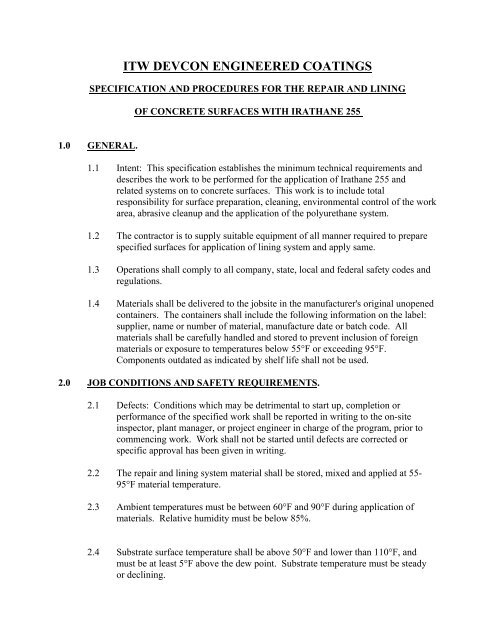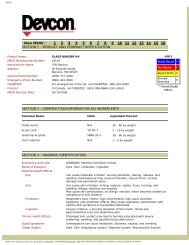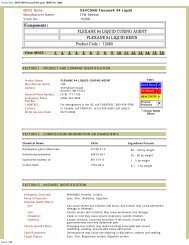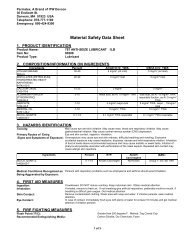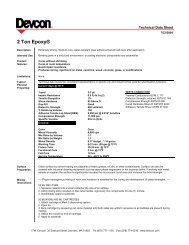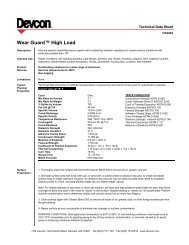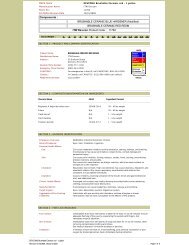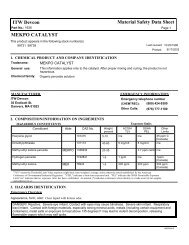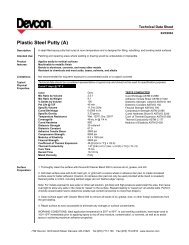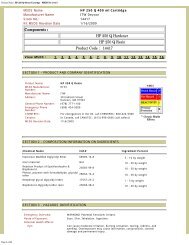ITW DEVCON ENGINEERED COATINGS
ITW DEVCON ENGINEERED COATINGS
ITW DEVCON ENGINEERED COATINGS
- No tags were found...
You also want an ePaper? Increase the reach of your titles
YUMPU automatically turns print PDFs into web optimized ePapers that Google loves.
<strong>ITW</strong> <strong>DEVCON</strong> <strong>ENGINEERED</strong> <strong>COATINGS</strong>SPECIFICATION AND PROCEDURES FOR THE REPAIR AND LININGOF CONCRETE SURFACES WITH IRATHANE 2551.0 GENERAL.1.1 Intent: This specification establishes the minimum technical requirements anddescribes the work to be performed for the application of Irathane 255 andrelated systems on to concrete surfaces. This work is to include totalresponsibility for surface preparation, cleaning, environmental control of the workarea, abrasive cleanup and the application of the polyurethane system.1.2 The contractor is to supply suitable equipment of all manner required to preparespecified surfaces for application of lining system and apply same.1.3 Operations shall comply to all company, state, local and federal safety codes andregulations.1.4 Materials shall be delivered to the jobsite in the manufacturer's original unopenedcontainers. The containers shall include the following information on the label:supplier, name or number of material, manufacture date or batch code. Allmaterials shall be carefully handled and stored to prevent inclusion of foreignmaterials or exposure to temperatures below 55°F or exceeding 95°F.Components outdated as indicated by shelf life shall not be used.2.0 JOB CONDITIONS AND SAFETY REQUIREMENTS.2.1 Defects: Conditions which may be detrimental to start up, completion orperformance of the specified work shall be reported in writing to the on-siteinspector, plant manager, or project engineer in charge of the program, prior tocommencing work. Work shall not be started until defects are corrected orspecific approval has been given in writing.2.2 The repair and lining system material shall be stored, mixed and applied at 55-95°F material temperature.2.3 Ambient temperatures must be between 60°F and 90°F during application ofmaterials. Relative humidity must be below 85%.2.4 Substrate surface temperature shall be above 50°F and lower than 110°F, andmust be at least 5°F above the dew point. Substrate temperature must be steadyor declining.
2.5 Adequate ventilation is to be maintained at all times in the work area. Open firesand spark producing equipment shall not be used in or near work areas during theapplication of Irathane 255.2.6 Post "No Smoking" and "Fire Hazard" warning signs in work area during and forat least forty-eight (48) hours following the application of Irathane 255.2.7 Applicators shall wear self-contained breathing apparatus or air hood, clean softsoled shoes, full cover clothing, and shall use chemical splash goggles. Generalventilation, combined with rubber gloves and safety glasses is sufficient for CR-90 and CS 1000 application work.2.8 Adequate lighting shall be provided to sufficiently light up all areas to be workedon without inclusion of shadow areas.2.9 All materials should be handled in accordance with all precautions recommendedin Material Safety Data Sheets.3.0 INSPECTION.3.1 All work including rigging of staging, lighting, ventilation, surface preparation,application and curing of the lining system shall be carried out to the satisfactionand approval of the Inspector and/or Owner.3.2 Any proposed deviation from the specified procedures as contained herein, thatmay be deemed necessary, shall be reported in writing as per specification 2.1.3.3 A daily log must be maintained by the Inspector to record application conditions.3.4 A final inspection of the lining system should be performed after installation ofequipment to assure a holiday free lining.3.5 Specific inspections should be performed for each stage of lining work asspecified.4.0 SURFACE PREPARATION.4.1 The compressed air used for all coating work shall be free of oil, water, or othercontaminants. Oil and water filter/separators shall be installed in the air supply.4.2 All areas that are not to be coated should be properly protected prior to thecommencement of surface preparation procedures.
4.3 Surfaces that contain oil or other contaminants shall be cleaned completely priorto blasting.6.1 New concrete shall be allowed to cure for a minimum of thirty (30) days prior tocoating or pass one of the following tests:4.4.1. Plastic film (ASTM D4263) - An 18" X 18" sample of 4 mil minimumgauge polyethylene is taped to the concrete surface and allowed toremain for 16 hours. Any evidence of moisture accumulation isunacceptable.4.4.2 Calcium chloride (ASTM F1869) - A preweighed (approx 30 gm weighedaccurate to within 0.1 gm) cup of anhydrous calcium chloride is placed ona section of the floor and is covered with a sealed canopy for 60-72 hours.The weight increase is converted to a value based upon the coveredsurface area and the time. Three pounds of water per 1000 sq. ft. per 24hours is the maximum acceptable amount for a surface to be coatedsuccessfully.4.5 All concrete surfaces should be grit-blasted to produce a rough and clean surfacefinish. Care should be taken to make sure all loose concrete is removedcompletely. Alternate methods of surface preparation include, wet grit blasting,high or ultrahigh water blasting, scarifying, and acid etching.4.6 All loose surface contamination of the concrete shall be completely removed byvacuuming and/or sweeping. The substrate must be visibly dry beforeproceeding. Any specific area that is not visibly dry or is experiencing waterpenetration, i.e., ground water seepage shall be surface-dried utilizing forced airheating units. (For the application of CS1000, the depth of dryness is not criticalas long as the immediate surface is free of dampness and is visibly dry.)4.7 Surface defects such as pinholes, rock holes, bug holes, mold ridges, etc. shall berepaired prior to coating with CR 90.4.7.1 Following sand blasting and cleaning of surface CR 90 is to be mixed withsand in a 2:1 ratio of CR 90 to sand. The mixture is to be used to fillallvoids and depressions in the concrete to provide a smooth and levelsurface for coating.4.8 All steel to be coated such as welds, edges, corners and other protrusions shouldbe ground in accordance with the surface finish requirements of NACE standardRP0178-91 and primed with SA 200 metal primer.5.0 PRIMING AND SEALING OF NEW CONCRETE.
5.1 CS2000 should not be applied under direct sunlight or when the temperature isincreasing. It should be applied when the temperature is declining or constant.(Late afternoon and on, until pre-dawn.)5.2 CS2000 is a 2-component epoxy primer/sealer that can be sprayed or rolledover rough concrete surfaces to provide an acceptable substrate for the applicationof Irathane 255. Care should be taken to produce a "pinhole" free surface,more than one coat of CS2000 may be required. All primed surfaces must beinspected prior to the application of Irathane. Please refer to Product DataBulletin for mixing and additional application instructions.5.3 CS2000 will provide excellent adhesion direct to Irathane when the Irathaneis applied within 24 hours following the CS 2000 application. Irabond UU-96Adhesive must be applied only if more than 24 hours but less than 48 hours haveelapsed. Under no conditions must more than 2 days elapse after the CS 2000application and prior to the UU-96 application. This situation would requireextensive grinding and surface roughening.5.4 Whenever Irabond UU-96 is applied, no more than 5 hours must elapse beforeeither the Irathane is applied or else an additional coat of UU-96 is applied.5.4 Allow a minimum of 4 hours prior to the application of Irathane over CS2000.5.5 All of the above recoat times are temperature sensitive. Temperatures below70°F will lengthen the recommended recoat times and temperatures above 70°F willshorten the recommended recoat times.5.6 Before proceeding with the coating application it is necessary to generally inspectthe substrate at this time. There must be no sharp corners and all edgesshould berounded. Surface tension of the coating will cause reducedthickness in theselocations and acceptable coating gauge may not beobtained. Acceptable roundededges will be approximately 0.090 inchesradius or larger.6.0 ADHESIVE APPLICATION6.1 Irabond UU-96 Adhesive is a one component adhesive system that can be sprayedor rolled over the primed surface at a rate of 250-300 sq. ft. per gallon. UU-96should be applied at a 2-3 mil wet film thickness.6.2 A coat of UU-96 Adhesive shall be applied within forty-eight (48) hoursfollowing the application of CS 2000 Primer.6.3 Minimum recoat window for Irabond UU-96 is fifty (50) minutes, maximumrecoat window is five (5) hours. TO AVOID ADDITIONAL WORK, DO NOTSURPASS THIS RECOAT WINDOW.
6.4 If the recoat window is surpassed, however, if it is less than twenty-four (24)hours at 75°F, an additional coat of UU-96 must be applied, if it is morethan twenty (24) hours, the surface once again must be blasted to original surfacepreparation requirements as per Section 4.0.7.0 COATING APPLICATION.7.1 Recommended application equipment for Irathane 255 is trowel or stiff bristlebrush.7.2 Irathane 255 is a 2-component (5:1 mix ratio) polyurethane elastomeric coatingsystem that shall be trowel applied over the primed and adhesive interbondedsurface in one application of 100 - 310 mils wet film thickness to achieve 80 –250 mils dry film thickness. Wet Irathane 255 will shrink approximately 20%.7.3 Do not thin or cut Irathane 255 or Irabond UU-96.7.4 Irathane 255 should be "box mixed" (mix in large container, than remix materialin original containers to "rinse Out" residues in the containers). This procedurewill ensure the proper mixing of Polymer and Curative as well as reducehazardous waste since mixed and cured Irathane 255 can be disposed of as nonhazardoussolid waste. Note: unevaporated flammable solvents can stillcontribute fire hazards. All waste must be handled in accordance with all local,state and Federal Regulations.7.5 Allow a minimum recoat time of 4 hours and a maximum of 24 hours at 70°F. Ifthe recoat time exceeds twenty four (24) hours, but is less than thirty six (36)hours, a coat of Irabond UU-96 adhesive must be applied over the semi-curedcoating prior to additional build coats of Irathane 255.7.8 If recoat time exceeds thirty six (36) hours, the cured surface must be roughenedor abraded, cleaned, and UU-96 adhesive applied prior to additional applications.7.9 The second coat shall be applied utilizing the same procedure as the first buildcoat.8.0 FINAL INSPECTION.8.1 All lined surfaces should be visually inspected for surface irregularities anddefects.
8.2 On steel surfaces, spark testing should be performed on the final cured lining at100 volts/mil.8.3 All defects and pinholes should be repaired in accordance with section 9.0 of thisspecification.8.4 Allow a minimum cure time of 2 days at 75°F before removing staging to preventphysical damage to the lining. Ventilation of the work area may be required for 7days after coating application to ensure total solvent dispersion.9.0 REPAIR PROCEDURES.9.1 Thoroughly abrade damaged areas with a no. 16 or 24 grit size Carborundum discor equal.9.2 Wipe abraded area with a clean cloth that has been saturated with Xylene orequivalent solvent.9.3 Irabond UU-96 Adhesive, shall be brushed over the abraded and cleaned area in asingle coat at .003 - .004 inches wet film thickness. Allow 30 minutesminimumdrying time at 75°F and a maximum recoat time of 2 hours.9.4 Irathane 255 shall then be brushed or trowel applied over the prepared area as perinstructions in this specification. DO NOT APPLY IRATHANE 255 TOSURFACES THAT HAVE NOT BEEN PREPARED.9.5 All damaged areas should be built up to original thicknesses and/or requireddimensions.9.6 All repaired and lined areas should be allowed to cure for a minimum of 4 days at75°F prior to immersion service.FOR TECHNICAL ASSISTANCE PLEASE CALL 1-800-876-2543.


